
The Piper PA-46 Malibu and Matrix are a family of American light aircraft manufactured by Piper Aircraft of Vero Beach, Florida. The aircraft is powered by a single engine and has the capacity for one pilot and five passengers. Early Malibus were all piston-engined, but a turboprop version, introduced as the Malibu Meridian but now called the M500, is also available. Currently, Piper offers the M350, M500, and M600 in the PA-46 family.
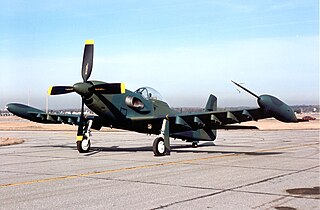
The Piper PA-48 Enforcer is an American turboprop-powered light close air support aircraft built by Piper in the 1970s. It is a development of the World War II-era North American P-51 Mustang fighter. The Enforcer concept was originally created and flown as the Cavalier Mustang by David Lindsay, owner of Cavalier Aircraft, in response to the United States Air Force PAVE COIN program, but Cavalier did not have the manufacturing abilities to mass-produce the Enforcer, so the program was sold to Piper by Lindsay in 1970.

The Cessna 441 Conquest II is the first turboprop powered aircraft designed by Cessna, and was meant to fill the gap between their jets and piston-engined aircraft. It was developed in November 1974, with the first aircraft delivered in September 1977. It is a pressurized, 8–9 passenger turbine development of the Cessna 404 Titan.
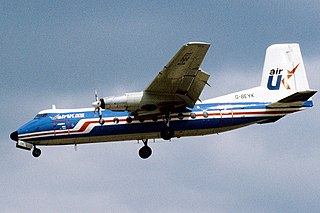
The Handley Page Dart Herald is a 1950s British turboprop passenger aircraft.

The Transavia PL-12 Airtruk is a single-engine agricultural aircraft designed and built by the Transavia Corporation in Australia. The Airtruk is a shoulder-wing strut braced sesquiplane of all-metal construction, with the cockpit mounted above a tractor-location opposed-cylinder air-cooled engine and short pod fuselage with rear door. The engine cowling, rear fuselage and top decking are of fibreglass. It has a tricycle undercarriage, the main units of which are carried on the lower sesquiplane wings. It has twin tail booms with two unconnected tails. Its first flight was on 22 April 1965, and was certified on 10 February 1966.
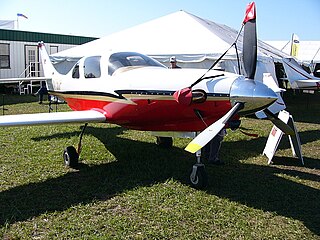
The Lancair Propjet is a four-seat, pressurized, composite aircraft powered by a 750-hp Walter M601E turboprop engine. The aircraft is based on Lancair's successful kit-plane, the Lancair IV. Like its piston-powered predecessor, the Propjet is noted for its performance, with a typical cruise speed of 325 knots at 24,000 feet and a climb performance of 4,000 feet per minute.
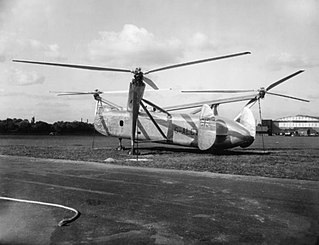
The Cierva W.11 Air Horse was a helicopter developed by the Cierva Autogiro Company in the United Kingdom during the mid-1940s. The largest helicopter in the world at the time of its debut, the Air Horse was unusual for using three rotors mounted on outriggers, and driven by a single engine mounted inside the fuselage.

The Avro 701 Athena is a British advanced trainer aircraft built by Avro in the late 1940s. It was designed to replace the North American Harvard in the Royal Air Force, but was bought only in small numbers, the competing Boulton Paul Balliol being preferred.
The Civil Aviation Department Revathi was a light utility aircraft designed in India principally for use by that country's flying clubs.

The Savoia-Marchetti S.59 was a 1920s Italian reconnaissance/bomber flying boat designed and built by Savoia-Marchetti for the Regia Aeronautica.
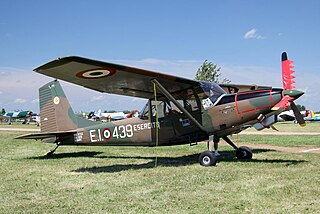
The SIAI-Marchetti SM.1019 is an Italian STOL liaison monoplane built by SIAI-Marchetti for the Italian Army, and based on the Cessna O-1 Bird Dog.

The Extra EA-400 is a six-seat, single-engined, high-wing monoplane produced by Extra Flugzeugbau GmbH. The EA-400 is powered by a liquid-cooled Continental Voyager turbocharged piston engine.
The Tupolev '102' and Tupolev '101' were 1950s projects for a turboprop airliner and assault transport by the Tupolev Design Bureau. The aircraft designs were almost identical but the '101' had a rear loading ramp and tail barbette for two Nudelman-Rikhter NR-23 cannon. The internal arrangement also differed with the '101' cabin being unpressurised apart from the flightdeck and a small cabin for ten passengers, whilst the '102's pressurised cabin was in one section, configured for 40 passengers.

The Wassmer WA-80 Piranha is a French two-seat low-wing cabin monoplane trainer designed and built by Société Wassmer. Based on the same construction as the company's WA-50 four-seater, the WA-80 was a scaled down version. The prototype, registered F-WVKR, first flew in November 1975 powered by a 100 hp Rolls-Royce Continental O-200 engine. Wassmer appointed a receiver and suspended production in 1977 after 25 had been built.
Miles M.26 was the designation used to cover the family of X-series design proposals, for long-range transport aircraft. The common factors of most X design proposals were the use of a blended wing body and engines buried in the wings, based on principles patented by Nicolas Woyevodsky. A sub-scale prototype of the X.9 proposal was constructed, designated the Miles M.30.
The Supermarine Type 179 "Giant" was a British monoplane flying boat developed by Supermarine but cancelled before completion.
The Ultra-Leicht Flugtechnik Speedy Mouse is a German ultralight aircraft, designed and produced by Ultra-Leicht Flugtechnik of Braunschweig. The aircraft is supplied as a complete ready-to-fly-aircraft.

The St-Just Cyclone, also called the St-Just Cyclone 180, is a Canadian homebuilt aircraft that was designed and produced by St-Just Aviation of Mirabel, Quebec. The company has since moved to Boucherville, Quebec. While it was available the aircraft was supplied as a kit and in the form of plans for amateur construction.

The Micronautix Triton is an American 3-5 passenger sightseeing and flight experience aircraft.
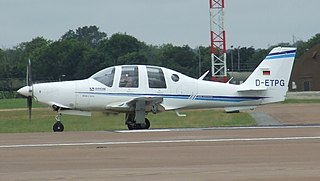
The Grob G140TP is a four-seat light aircraft built by Grob Aircraft.















